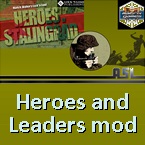asl3d
Posts: 6531
Joined: 2/6/2017
Status: offline

|
H&L Soviet Spotters
Up to the beginning of the war in 1941, the training of the Russian artillery was undoubtedly conducted on the basis of the "Field Service Regulation for the Red Army," which contained a number of items from the former German Army Manual No. 300 entitled "Operations," on the basis of the field manual, and of the firing manual of the Russian artillery. Even the very first engagements showed that these manuals, which were sound, had not yet been fully assimilated by the Russian artillery. Occasionally the Russians added artillery fire to the fire of their mortars when shelling combat installations on the German main line of resistance and the German battle positions. This coordinated fire apparently was designed to facilitate the capture of German prisoners for the Russian intelligence service, especially since the enemy had been notably stepping up his reconnaissance activity in the air and on the ground since the end of June. In this combination of mortar and artillery fire one and the same artillery observer most likely directed first the 80-mm mortars and then the 75-mm cannons, or 120-mm mortars and 122-mm howitzers, or even mortars and guns in an inverse ratio to their calibers. It was rarely possible to locate Russian observation posts, and even if they wore located it was still very difficult to neutralize them. The sound-ranging batteries, as rule, were unable to detect the 80- and 120-mm mortars, since the sounds which their muzzle waves produced were rather low. At that time there we're no infantry sound-ranging detachments with equipment particularly adapted to these circumstances. The Russian batteries, were situated so far to the rear of the Russian main line of resistance that although they were able to hit the German battle position with long-range fire, they could not, in turn, be reached by the German artillery from normal firing positions. On the other hand, when the Germans were attacking, the Russian artillery was always in a position to support its infantry by shelling any assembling German forces which had been identified and by firing a barrage in front of the Russian main line of resistance and shelling any German penetrations into the Russian battle position. When the Russians conduct a defense with weak artillery, especially on the broad front, mortars of the infantry and elements of heavy machine gun units are attached to the divisional artillery in addition to the heavy mortar battalions which are regularly assigned to the artillery. In these arduous war years, the Russian artillery became a dangerous opponent whose powers cannot be rated too highly. To an extent which at first seemed inconceivable, it learned from its bitter experience during the summer and fall campaign of 1941 and it pointed to appropriate conclusions. The divisional artillery, consisting of artillery battalions of various calibers, is in the habit of engaging in observed fire for the direct support of the infantry, while the artillery battalions of the GHQ artillery, which are uniform in caliber, are inclined — no matter whether they are parts of GHQ artillery regiments, brigades, or even divisions — to undertake unobserved fire and fire with the aid of sound-ranging, flash ranging, balloon and aircraft observation, and radio direction finding, and to engage in concentrations aid rolling barrages.

 Attachment (1) Attachment (1)
_____________________________
Semper fidelis
|
 Printable Version
Printable Version






























 New Messages
New Messages No New Messages
No New Messages Hot Topic w/ New Messages
Hot Topic w/ New Messages Hot Topic w/o New Messages
Hot Topic w/o New Messages Locked w/ New Messages
Locked w/ New Messages Locked w/o New Messages
Locked w/o New Messages Post New Thread
Post New Thread